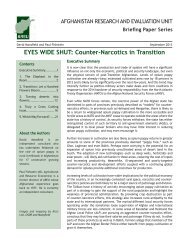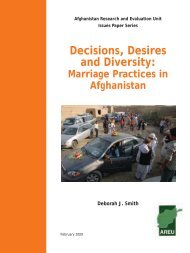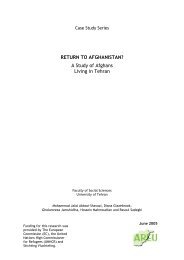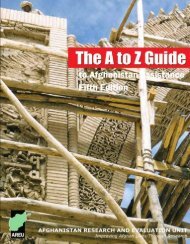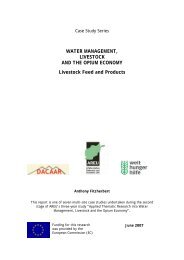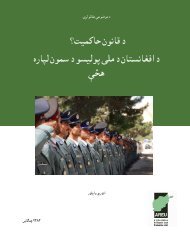Local Governance in Afghanistan: A View from the Ground
Local Governance in Afghanistan: A View from the Ground
Local Governance in Afghanistan: A View from the Ground
- No tags were found...
You also want an ePaper? Increase the reach of your titles
YUMPU automatically turns print PDFs into web optimized ePapers that Google loves.
<strong>Afghanistan</strong> Research and Evaluation Unit<br />
2011<br />
This paper argues that <strong>the</strong> district represents <strong>the</strong> lowest feasible adm<strong>in</strong>istrative tier through which<br />
adm<strong>in</strong>istration can realistically take place and services be delivered <strong>in</strong> a coord<strong>in</strong>ated manner.<br />
The prospect of deal<strong>in</strong>g with almost 40,000 village bodies (as opposed to 364 districts), a number<br />
<strong>in</strong>cidentally not yet achieved even under present programme arrangements, represents an impossible<br />
task. The second reason for a focus on <strong>the</strong> district is that it allows for coherent and <strong>in</strong>tegrated<br />
plann<strong>in</strong>g that maximises <strong>the</strong> use and distribution of scarce resources between manteqas/hawzas<br />
and <strong>the</strong>ir villages. Thirdly <strong>the</strong>re is an issue of cont<strong>in</strong>uity. On a village level, most CDCs are only<br />
active as long as <strong>the</strong>re are funds and projects to be implemented. When <strong>the</strong>se cease, CDCs become<br />
redundant and village governance ei<strong>the</strong>r reverts to traditional <strong>in</strong>stitutions or is undertaken by hybrid<br />
shuras that <strong>in</strong>clude, but are not composed exclusively of, CDC members. Establish<strong>in</strong>g accountability<br />
and plann<strong>in</strong>g capacity at <strong>the</strong> district would allow for <strong>the</strong> presence of permanent bodies to fulfil<br />
<strong>the</strong>se functions on a cont<strong>in</strong>uous basis. As <strong>the</strong> 2007 formation of successful district-level shuras <strong>in</strong><br />
Laghman by <strong>the</strong> <strong>the</strong>n-prov<strong>in</strong>cial governor shows, <strong>the</strong>re is a clear space and an identified need for<br />
representation at this level. The members of this shura were of higher status than <strong>the</strong> DDAs, even<br />
though <strong>the</strong>re was and rema<strong>in</strong>s some <strong>in</strong>term<strong>in</strong>gl<strong>in</strong>g of membership.<br />
Membership of Afghan <strong>in</strong>stitutions at district level and below is extremely flexible and pragmatic,<br />
and shuras are often adapted for specific purposes. This is particularly <strong>the</strong> case <strong>in</strong> dispute resolution<br />
where certa<strong>in</strong> members may be more qualified than o<strong>the</strong>rs. One problem this research has highlighted<br />
is <strong>the</strong> recent proliferation of shuras to meet <strong>the</strong> demands of government and o<strong>the</strong>rs. Frequently such<br />
bodies have several members <strong>in</strong> common; <strong>in</strong>deed, it would be surpris<strong>in</strong>g were this not <strong>the</strong> case s<strong>in</strong>ce<br />
<strong>in</strong> any community leadership tends to be limited to a select few. To fragment this leadership by<br />
<strong>in</strong>troduc<strong>in</strong>g additional shuras risks underm<strong>in</strong><strong>in</strong>g community cohesion and thus <strong>the</strong> community itself.<br />
It is <strong>the</strong> community that legitimates its representatives to higher structures, be <strong>the</strong>y clusters, DCCs<br />
or DDAs. However, Afghan society at every level, whe<strong>the</strong>r it be <strong>the</strong> village, district or elsewhere, is<br />
replete with compet<strong>in</strong>g factions, and respondents warned that <strong>in</strong>troduc<strong>in</strong>g so many forms of local<br />
representation threatened to disturb locally-achieved equilibrium. 123<br />
Fur<strong>the</strong>rmore, <strong>in</strong> encourag<strong>in</strong>g or request<strong>in</strong>g <strong>the</strong> formation of local <strong>in</strong>stitutions by external agents<br />
more consideration needs to be given to <strong>the</strong> motivations of those who spend <strong>the</strong>ir time and money<br />
participat<strong>in</strong>g <strong>in</strong> shuras and more formal councils. While <strong>the</strong>re appears to be an outside assumption<br />
that membership of councils such as CDCs and DDAs is driven by a sense of public duty, reasons for<br />
participation are often l<strong>in</strong>ked to issues of status and personal <strong>in</strong>centives. The persistence of <strong>the</strong><br />
unpaid DDAs was not so much to do with <strong>the</strong> altruistic <strong>in</strong>tentions of <strong>the</strong>ir members as <strong>the</strong> important<br />
role <strong>the</strong>y played <strong>in</strong> <strong>the</strong> distribution, and diversion, of WFP <strong>in</strong>puts. The practice of giv<strong>in</strong>g a stipend<br />
to DCC members reflects a more realistic approach, not just to encourage <strong>the</strong>ir participation, but as<br />
provid<strong>in</strong>g a good reason for <strong>the</strong>ir “constituents” to demand that <strong>the</strong>y attend and produce results on<br />
<strong>the</strong>ir behalf. It encouraged obligation.<br />
F<strong>in</strong>ally, <strong>the</strong> meso level represented by <strong>the</strong> district is particularly important <strong>in</strong> that it represents an<br />
arena of manageable dimensions where people can meet with relative ease, even <strong>in</strong> <strong>the</strong> most rugged<br />
terra<strong>in</strong>. The district centre has usually been a focal po<strong>in</strong>t for trade as well as adm<strong>in</strong>istration. The<br />
district shura and district adm<strong>in</strong>istration also provides a realistic means for adm<strong>in</strong>istrators, elected<br />
officials and <strong>in</strong>formal powerholders <strong>in</strong> <strong>the</strong> prov<strong>in</strong>cial centre to engage with local populations.<br />
Policy Issues: Follow<strong>in</strong>g <strong>the</strong> argument that <strong>the</strong> district is <strong>the</strong> lowest feasible organisational tier<br />
of government, <strong>the</strong>re is a clear need to establish a s<strong>in</strong>gle representative body at <strong>the</strong> district level<br />
furnished with appropriate powers. This body needs to be accountable to those it represents and<br />
capable of hold<strong>in</strong>g o<strong>the</strong>rs to account for <strong>the</strong> delivery of services, justice and security. It will also<br />
require <strong>the</strong> capacity and resources to fulfil its responsibilities for plann<strong>in</strong>g, monitor<strong>in</strong>g and f<strong>in</strong>ancial<br />
scrut<strong>in</strong>y. In light of <strong>the</strong> cost and technical challenge that conduct<strong>in</strong>g SNTV-based elections at a<br />
district level would represent, it would currently be more practical to select district councillors by<br />
more consultative mechanisms follow<strong>in</strong>g <strong>the</strong> exist<strong>in</strong>g ASOP DCC model as applied <strong>in</strong> Helmand. Given<br />
123 Noah Coburn, “Many Shuras Do Not a Government Make: International Community Engagement with <strong>Local</strong> Councils <strong>in</strong><br />
<strong>Afghanistan</strong>” (Wash<strong>in</strong>gton, DC: United States Institute for Peace, 2010).<br />
<strong>Local</strong> <strong>Governance</strong> <strong>in</strong> <strong>Afghanistan</strong>: A <strong>View</strong> <strong>from</strong> <strong>the</strong> <strong>Ground</strong><br />
58



